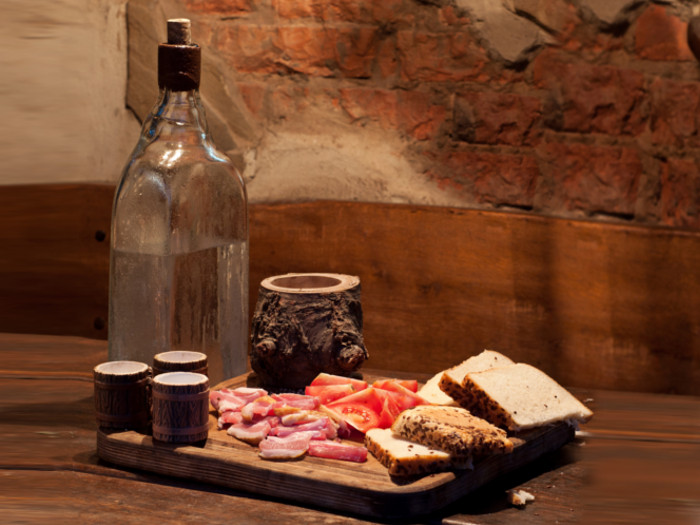Learning how to make moonshine is becoming increasingly popular. While the production has recently been taken up by big-name distilleries, this clear and unaged whiskey has a long history of being made at home for a range of purposes. [1]
How to Make Moonshine?
To make moonshine legally, you need a license. It is vital to take thorough safety precautions and use the right equipment.
Equipment for Making Moonshine
- Drill with 1/4″ bit
- Sole purpose pressure cooker
- 1/4″ wide copper tubing
- 15 gallon (or bigger) metal pot
- Sterilized large plastic storage bucket
- New or sterilized cheesecloth
- Sterilized large wooden spoon
- String or tape

Moonshine is distilled homemade whiskey, usually with high alcohol content. Photo Credit: Shutterstock
Method
- Step 1: With a 1/4″ bit, drill a hole in the top of the cooker.
- Step 2: Insert the copper tubing, which should fit tightly and come through the underside of the lid no more than an inch.
- Step 3: The tube will go from the cooker to the sink, and from the sink back to the ground.
- Step 4: Ensure that your tubing is the right length for this purpose.
Ingredients for 10-gallon mash (40l)
- 10 gallons of Spring Water
- 14 lbs (4.2kg) of cracked corn, free of preservatives.
- 14 lbs (4.2kg) of granulated sugar
- 2 tbsp of distillers yeast
Making the Mash
To make the mash, please refer the following steps:
- Step 1: Boil the water to a rolling boil.
- Step 2: Stir the cornmeal into the water until it becomes a paste.
- Step 3: Remove mixture and, once cool, pour into the bucket.
- Step 4: Stir in the yeast and sugar.
Fermentation
The fermentation process allows the yeast to convert the sugars into alcohol.
- Step 1: With string or tape, cover the bucket with the cheesecloth.
- Step 2: Store in a dark, cool location.
- Step 3: Observe the production of light brown foam and bubbles on top of the liquid.
- Step 4: When the liquid stops producing this foam, the sugars are fully converted and it is ready for distillation.
Distillation
The distillation process involves the following steps. Let us take a look at them in detail below.
- Step 1: Strain the fermented mash (known as ‘sour mash’) through the cheesecloth into a clean metal pot, discarding any leftover lumps.
- Step 2: From the pot, transfer the sour mash into the pressure cooker and put the lid on.
- Step 3: Ensure the tubing runs from the lid of the cooker to a sink filled with cold water.
- Step 4: Position the tube so that it coils at the bottom of the sink (weigh down with a bottle if necessary) and then bring the tube out of the sink to a container on the ground.
- Step 5: With constant monitoring, heat the contents of the cooker to no more than 177°F (80 °C).
- Step 6: Discard any toxic liquid that comes out of the copper tube before the pressure cooker reaches the optimum temperature.
- Step 7: When you have finished the collection of the liquid at 177°F (80 °C) (no lower or higher) you can transfer the 90-95% proof alcohol to jars. It can be used for a variety of purposes.
- Step 8: Reduce the alcohol content to half by adding water.
Once diluted, it can be consumed, but extreme moderation is still recommended.
Risks & Side Effects
The risks involved with drinking excessive alcohol can be short term such as violence and injuries to long-term health risks such as chronic diseases. According to the Centers for Disease Control and Prevention, people who should not drink alcohol include women who are pregnant, individuals younger than 21 years of age, and people who are recovering from alcoholism or cannot control the amount they drink. Also, it should be avoided by people who are planning to drive or any other activity that required focus and skill. However, different countries have different rules on alcohol purchase and consumption. [2]
